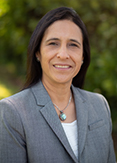Nicole Stern is an enrolled member of the Mescalero Apache Tribe of New Mexico and is the first member of her tribe to become a physician. She graduated from the University of Arizona College of Medicine in Tucson, where she completed a residency in Internal Medicine. She was a fellow in Primary Care Sports Medicine at the University of Oklahoma Health Sciences Center in Oklahoma City, and completed a Master’s in Public Health degree in Health Management from Harvard T.H. Chan School of Public Health. She was a Commonwealth Fund Fellow in Minority Health Policy at Harvard Medical School and her practicum project focused on American Indian physician workforce development.
Currently, Dr. Stern is an Assistant Professor of Medical Education at the California University of Science and Medicine in the Inland Empire of Los Angeles, a part-time urgent care physician, and a primary care sports medicine team physician for sport clubs at the University of California, Santa Barbara Department of Recreation. She is a fellow of the American College of Physicians and has extensive experience with the Association of American Indian Physicians (AAIP), having served as President-Elect, President, Immediate Past President, and a two-time At-Large-Director of the Board of Directors.
For 7 years, Dr. Stern served as the liaison from AAIP to the Association of American Medical Colleges’ (AAMC) Committee on Student Diversity Affairs, and currently sits on AAMC’s Strategic Action Plan 4 Advisory Council. In addition, Dr. Stern is on the Summer Health Professions Education Program’s American Indian/Alaska Native National Engagement Committee and continues to work closely with the AAMC to collaborate on strategic plans and initiatives that emphasize the need to increase the American Indian and Alaska Native physician workforce with the goal of improving health care, and reducing health care disparities, for AI/AN people. As one example of Dr. Stern’s career investment, she helped create the “American Indians Accessing Health Professions Program” in 2013 which is a two-day program exposing American Indian and Alaska Native community college, tribal college and early university students to health professional and public health career options.


